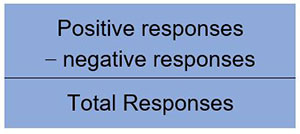Date Published May 19, 2020 - Last Updated December 10, 2020
Customer satisfaction (CSAT) is the result of delivering satisfactory services, providing easy access to these services, and offering unique capabilities or outstanding levels of service all of which translate to providing value to the customer. It’s in everything we do if we serve others.
Every aspect of how a business operates today is publicly exposed on the Internet, and we are constantly under the magnifying glass of how well we treat customers at a time when competition is tough. With the pressure on everyone, including internal IT to be the best, customer satisfaction is at the heart of every interaction, or should be.
CSAT Is Subjective
The challenge with delivering reliable customer satisfaction is that satisfaction is subjective, and a single periodic measurement is not enough. Providers need the ability to measure satisfaction quickly and easily, balancing the need against survey fatigue.
Satisfaction is subjective, and a single periodic measurement is not enough.

The metrics most commonly used for CSAT measurement programs include the following:
- Customer satisfaction survey score (CSAT)
- Customer Effort Score (CES)
- Net Promoter Score (NPS)
- Customer Churn Rate
Customer satisfaction is measured via surveys. Surveys can and should be taken on a regular basis, and there are several means of surveying customers:
- Engaging in regular surveys across all customers
- Surveying after every transaction
- Questioning why a customer has stopped doing business with the organization
Typically, a customer satisfaction survey will feature a number of questions designed to provide a full picture of what the provider does well and what can be improved. Taken together, a single average score can be tabulated and trended over time. Customer service can also be measured with a single question: “How satisfied are you with our service?”
Customer effort score measures how easy it is to do business or conduct a transaction and is critical to retention and sales. This score can be subjective, surveyed with one question: “How easy was it for you to do business with us today?” But you can also leverage website metrics to notice when a customer fails to execute a purchase or stops interacting with the website.
Net promoter score is another leading indicator of satisfaction and is particularly important given social media and its impact on a provider’s reputation. It’s also very easy to measure with a single yes/no question: “Based on your experience today, would you recommend us (or our service) to others?”
There are two aspects of this measure: the calculation (shown below) and the impact of the Yes/No response:

- “Yes” responses indicate promoters, the people who might recommend the business or say beneficial things about the business over social media (think Facebook “likes”)
- “No” responses indicate a true problem. These are detractors or people who will say poor things about their experience to others or via social media or discontinue the business relationship
Note that the formula for calculating NPS can change, depending on the design of your answer scale. If the respondent is required to choose Yes/No, the formula works as shown. If there is a scale that allows a passive answer, the calculation is a bit different. Read more in, Metric of the Month: Net Promoter Score, which distinguishes between promotors, passives, and detractors.
Customer churn rate is not a direct measure of CSAT but could be considered a lagging indicator if you consider the first three measures leading indicators. If the provider is not tending to the leading indicators (customer satisfaction, customer effort, and net promoter score), an eventual result will be an increase in the loss of customers.
Thus, customer churn rate is measured as the percentage of customers who have stopped doing business with a provider or:

Once a provider understands the drivers that lead to customer churn, they can use data analytics and artificial intelligence to alert a customer service agent to potential churn and offer perks to the customer in an effort to win back their loyalty, thus reducing churn.
Your CSAT Strategy
While these are all relatively easy ways to measure customer satisfaction, being successful with CSAT requires an ongoing and cohesive measurement strategy.
You need to develop a surveying strategy based on the vision and outcomes you are looking to achieve:
- Identify the metrics to be used and why
- Identify the means and frequency of collecting them
- Develop the questions to be used
- Implement them within the tools you use to serve customers or post-transaction email surveys
- Begin gathering the data
- Adjust the plan
Every type of business, industry, vertical market, or market space is highly competitive, and social media makes even small mistakes a public event. Additionally, every industry relies on people seeing value in the product or service they provide. There are choices in every industry: retail, education, health care, phone/cable, internet providers, and public utilities, even online businesses. With competition so high and failure so public, a CSAT program gives your company the data it needs and a means of using this data to ensure customer satisfaction and the overall customer experience remain positive.
Phyllis Drucker is an ITIL® certified consultant and information leader at Linium, a Ness Digital Engineering Company. Phyllis has more than 20 years of experience in the disciplines and frameworks of IT service management, as both a practitioner and consultant. She has served HDI since 1997 and itSMF USA since 2004 in a variety of capacities including speaker, writer, local group leader, board member, and operations director. Since 1997, Phyllis has helped to advance the profession of ITSM leaders and practitioners worldwide by providing her experience and insight on a wide variety of ITSM topics through presentations, whitepapers, and articles and now her new book on the service request catalog, Online Service Management: Creating a Successful Service Request Catalogue (International Best Practice). Follow Phyllis on Twitter @msitsm.